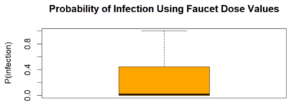More Code?!?!
Divya p -
Hey everyone, and welcome back to Week 4 of my project!
To give a brief recap of what we did last week, I coded a dose exposure function and a probability of infection function in the coding language R.
This week, I found out that those two equations are fundamental to all the different types of exposure I will be encoding into my overall risk model for L. pneumophila.
Let me explain: from last week, the dose equation was
and the probability of infection equation was
. So, we plug in whatever we get “dose” equal to into the P(infection) equation, and we should get the probability of infection for that particular dose we are investigating.
This week, my mentor presented me with three different types of dose exposure: faucet, shower, and toilet flushing. The shower dose exposure equation is
, the toilet flushing dose exposure equation is

, and the faucet dose exposure equation is
. Notice anything in common? They all have
in their equation somewhere, thereby making it the fundamental dose equation. We change the value of dose based on which dose we are talking about, being either faucet, toilet flushing, or shower.
My task this week (and next week because next week is spring break for ASU) is to encode faucet, shower, and toilet flushing dose exposure models into R and then find the probability of infection for each of them. So far, I was able to finish the faucet dose exposure and P(infection) (because it was the only one which didn’t involve a series function inside its equation — I will figure that out next week), and here are my results.


These results concur with scientific findings because the probability of infection for faucet dose exposure is supposed to be low, which is a great thing health wise.
Once I finish encoding faucet, shower, and toilet flushing dose exposures and probabilities of infection, these are three of the functions that I would need to eventually combine so I can make a large-scale risk model of L. pneumophila as I progress through this research project.
Until next week!

Comments:
All viewpoints are welcome but profane, threatening, disrespectful, or harassing comments will not be tolerated and are subject to moderation up to, and including, full deletion.